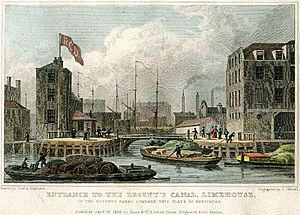Limehouse Basin facts for kids
The Limehouse Basin is a cool spot in Limehouse, London. It's like a watery doorway that connects the Regent's Canal to the big River Thames. Boats can travel through the Limehouse Basin Lock to get from one to the other.
This basin is a special kind of dock that used to be much bigger, covering about 15 acres (61,000 square meters). It sits between the Docklands Light Railway (DLR) tracks and a historic street called Narrow Street. Right next to it is a nice little park called Ropemaker's Fields.
Contents
History of Limehouse Basin
The Limehouse Basin was built by the Regent's Canal Company. It was first known as the Regent's Canal Dock. This dock was a busy place where large ships and smaller boats called lighters would unload their goods. These goods were then put onto canal barges. The barges would carry them further along the Regent's Canal.
A Busy Coal Hub
When it first opened in 1820, the dock wasn't very successful. But by the mid-1800s, things changed. The dock and the canal became super important. They were used to bring huge amounts of coal to London. This coal powered many gasworks and later, electricity stations along the canal. It was also used by homes and businesses.
At one point, Limehouse Basin was the main entrance from the River Thames to the entire canal network in the country. It was a really big deal for transport!
Decline and Revival
The dock's importance started to fade when railways became more popular. Trains could carry goods faster and to more places. However, during World War I and World War II, canal traffic picked up again. This gave the Limehouse Basin a brief return to its busy days.
The Docklands Light Railway (DLR) now runs on a bridge above the old wharves (loading areas) on the north side of the basin. This bridge was first built for the London and Blackwall Railway. Beyond these wharves, the Commercial Road Lock connects to the Regent's Canal.
The Accumulator Tower
To the east of the canal entrance, there's a cool octagonal (eight-sided) tower. This is a hydraulic accumulator tower, built in 1869. It replaced an older, pioneering one from the 1850s. This tower helped control the water pressure for all the machines around the basin. These machines were used to handle the coal.
The original steam engines and pumps that powered it are gone now. The building was later turned into a viewing platform. Today, the British Waterways Board owns it and the basin. It's a Grade II listed building, which means it's historically important. You can often visit it during the annual Open House Weekend in September.
Changes to the Locks
In the 1800s, as steam-powered ships got bigger, Limehouse Basin became too small for them. The way the basin connected to the River Thames and the Limehouse Cut was quite complicated.
Originally, the basin had three entrance locks to the Thames. These were used to separate big ships from smaller barges. The two smaller entrances upstream were later closed and filled in. In 1968, a new, short canal section was built. This reconnected the Limehouse Cut to the basin. Before this, the Cut had its own direct link to the Thames.
The basin stopped being used for commercial (business) traffic in 1969. Now, one part of the basin is still used by pleasure boats, like yachts and narrowboats.
Images for kids
-
The north quay jetty drawn by Gustave Doré. Notice hydraulic cranes.
See also
 In Spanish: Valle de Limehouse para niños
In Spanish: Valle de Limehouse para niños



























